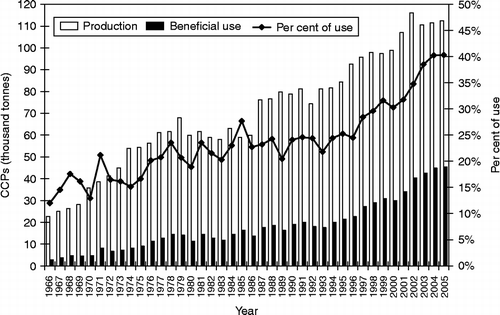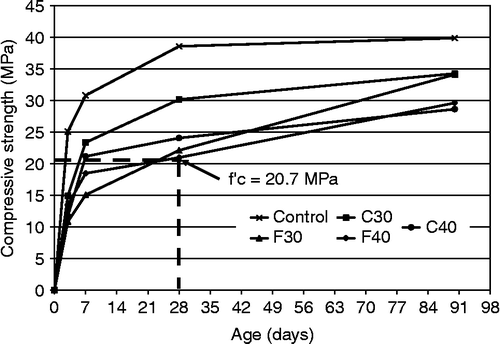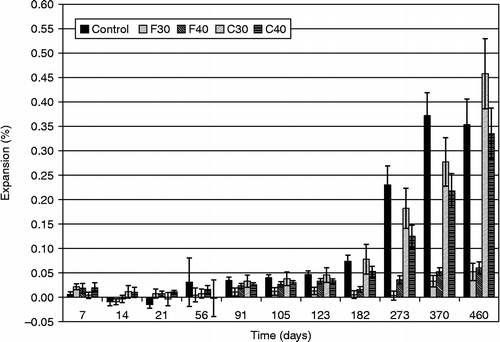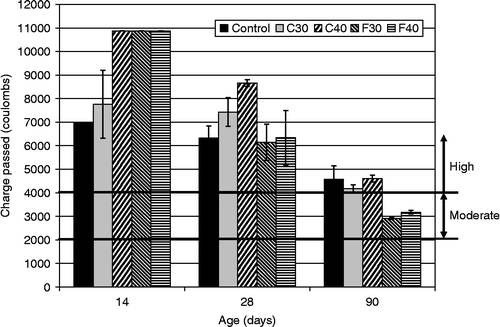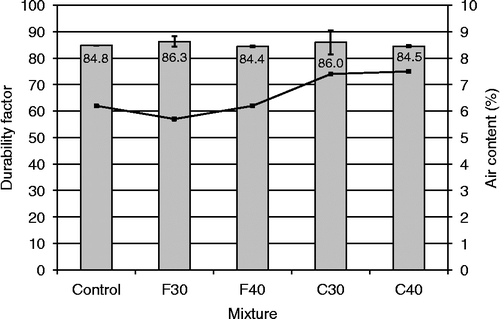Abstract
Cement production accounts for approximately 5% of total global CO2 emissions from all human activities. In addition, the consumption of virgin aggregates for concrete infrastructure has created virgin material scarcity issues in many areas of the USA. High-performance green concrete (HPGC) with fly ash and recycled aggregates can help reduce the demand for material inputs and reduce pollution outputs associated with bulk material flow of urban concrete. Structural and durability tests showed that HPGC containing fly ash and 50% recycled aggregate (100% of the coarse aggregate fraction) performed equally or better than 100% ordinary Portland cement concrete with the same cementitious content. Durability improvements were more significant with Class F than Class C fly ash. For both Class F and Class C fly ash, greater per cent replacement of Portland cement with fly ash led to slower and lower strength gain, but still within acceptable strength criteria for Colorado Department of Transportation Class B concrete. This paper quantifies the sustainability of HPGC in urban infrastructure by addressing structural performance, environmental, economic and resource depletion impacts.
1. Introduction
In developed nations, more than 75% of people reside in cities (UN Citation2003). In certain urban areas of the western USA, such as the Greater Phoenix and Denver areas, population has increased by 39% since 1995 (GPEC Citation2006) and 25% since 1990 (CDOLA Citation2006), respectively. The demand for materials required for the continual expansion and the maintenance of the concrete infrastructure for these growing urban centres are depleting nearby virgin resources. Construction sand and gravel operations are moving further from highly populated urban centres due to depletion, zoning, federal and state environmental law, and development regulations. As a result, many major municipalities of the USA are currently faced with material scarcity issues and higher emissions of greenhouse gases (GHGs) and higher unit costs per unit delivered concrete due to increased transportation of the required materials. According to the Producer Price Index data, nationally, from 2002 to mid-year of 2006, cement and concrete prices increased by approximately 30% and aggregate prices by about 27% (US Department of Labor Citation2006). The environmental and economic impacts of concrete flows for a municipality can be quantified using environmental life-cycle assessment (LCA) and life-cycle costing (LCC). Modelling using LCA/LCC techniques can also quantify the avoided environmental and economic impacts of using waste-stream materials as opposed to virgin resources.
Denver, Colorado, along with 295 other cities in the USA, has signed the US Mayors Climate Protection Agreement, and has committed to take action to meet or exceed the global GHG reduction goals articulated in the Kyoto Protocol (US Mayors Climate Protection Agreement Citation2005). In order to meet these goals, municipalities are now quantifying their carbon footprint and analysing material flows for potential reductions in emissions and cost. In addition, significant reductions in emissions of GHG and cost can be achieved if the concrete containing the waste-stream materials is more durable, thereby extending the service life of infrastructure. High-performance green concrete (HPGC) incorporates waste-stream materials to lower the economic and environmental impacts of infrastructure, while meeting, or exceeding, strength and durability requirements without compromising workability. The composition of HPGC includes water, cement, coarse and fine aggregate, and waste-stream materials (fly ash, blast furnace slag, recycled concrete aggregate, crushed glass, etc.). In the case of HPGC, the waste-stream materials are used to replace a portion or all of a particular component (cement, coarse or fine aggregate) of the concrete mixture.
This paper quantifies the emissions and cost savings and the potential for extended service life of infrastructure that can be achieved by incorporating HPGC into the concrete infrastructure of Denver, Colorado.
2. Background
2.1 Cement demand
Globally, Portland cement production contributes to approximately 5% of total CO2 emissions from all human activities (Worrell et al. Citation2001). Nationally, the consumption of Portland cement continues to increase in the public and private sectors. For example, the required Portland cement for the construction of an average single-family home has increased from 1984 to 2004 by 31.7 and 130.6% for public structures during the same period (Portland Cement Association (PCA) Citation2006). In other words, the residential home cement consumption has increased from 13.2 to 17.3 tonnes (14.5–19.1 US tons) while public structure consumption has increased from 20.65 to 47.63 million tonnes (22.767–52.506 million US tons) (PCA Citation2006).
The demand for Portland cement in the USA in 2005 was relatively constant, on a state-by-state comparison, with much of the nation's increasing demand for Portland cement by 5% when compared to 2004 (PCA Citation2006). The national annual per capita usage of Portland cement is approximately 0.41 tonnes (0.45 US tons) (PCA Citation2006). However, this proxy number does not reflect the intensity of concrete infrastructure in growing urban environments. As a comparison, regional proxy numbers obtained from the 2002 US Economic Census data were evaluated for per capita concrete consumption in the Denver–Aurora metropolitan statistical area (MSA; US Census Citation2002). The estimated urban per capita usage of concrete in the Denver–Aurora MSA was 0.52 tonnes/capita (0.57 US tons/capita), approximately 27% higher than that reported for the nation by the PCA.
2.2 Aggregate demand
In the USA, aggregate scarcity issues are, or will soon be, encountered in many urban environments as sand and gravel operations are moving further away from highly populated urban centres. The number of counties in the USA where the demand for aggregates equalled the output within the same county dropped by 50% between 1984 and 2004 (NRC Citation2004).
On a statewide basis, California currently imports approximately 1% of the aggregate it consumes from outside the USA. In 2005, California consumed about 193 million tonnes (213 million US tons) of construction aggregate or about 6 tonnes (6.6 US tons) per person. The projected 50-year demand for aggregate in California is 12,280 million tonnes (13,536 million US tons) and the currently permitted resources are only 3940 million tonnes (4343 million US tons) – less than one-third of the total demand (Kohler Citation2006). This shortage is already impacting cost, emissions and energy associated with increased transport. The highest priced aggregate in the state is in the San Diego area, where Portland cement concrete-grade sand (ASTM C33) is in very short supply and costs $22–$24/tonne ($20–$22/US ton) compared to $8/tonne ($7/US ton) in Colorado. This, in part, explains why sand is being imported from Mexico. The average distance for aggregate from southwestern Imperial County near Baja, Mexico, to downtown San Diego is 145 km (90 miles) with an increased freight-on-board price of $4.95/tonne ($4.50/US ton), or $0.11/tonne km ($0.17/ton mile) (Kohler Citation2006). The cost of C33-grade sand in the northern San Francisco Bay is $19.85/tonne ($18.01/US ton), again, prompting the market to import sand from Canada – shipped at a cost of approximately $20/tonne ($18.15/US ton) (Kohler Citation2006).
In the Colorado eastern slope, the weighted average per capita production and consumption of aggregates in the Denver area has remained steady at about 8 tonnes per capita (8.8 US tons per capita; USGS Citation1999). The Colorado Geologic Survey uses a per capita annual consumption of aggregates (concrete, roadbase, asphalt, structural fill, etc.) of 9.1 tonnes (10.0 US tons). As Colorado has an abundance of virgin resources of C33 fine aggregate, the primary concern for aggregate scarcity is C33 coarse aggregate. Virgin alluvial sources of the coarse aggregate include the high-energy fluvial corridors or crushed from blasted rock from the mountain quarries. As fluvial sources deplete, the higher energy sources of crushed stone from the Colorado Rocky Mountains have been more common. In 1997, aggregates produced in the Denver area were derived from alluvial sand and gravel sources (55%), crushed stone (31%) and recycled aggregates (14%). In contrast, in 1960, aggregates were derived principally from alluvial sand and gravel sources (99%; USGS Citation1999).
The primary source of alluvial coarse aggregates for concrete in the Colorado eastern slope is the South Platte River corridor. Responsibility for the permitting of aggregate mines falls under the Colorado Department of Minerals and Geology (CDMG) jurisdiction. The CDMG maintains a geographic information system (GIS) database of the permitting date, coordinates, mine type and current status of all aggregate mines in Colorado (CDMG Citation2006). Application of GIS tools allowed the collection and organisation of the spatial and related attribute data on the location of facilities for virgin and recycled materials. Using this information, aggregate mines were plotted and a buffer zone was imposed to identify those aggregate mines within a 3.2 km (2 miles) buffer of the South Platte River and the high-energy tributaries such as Boulder Creek and Clear Creek as shown in Figure (a),(b). Figure (a) shows all mines within the counties containing the South Platte River and the 2 mile buffer shown in the shaded region along the South Platte. Figure (b) shows only those mines within the buffer and 30 km (18.6 mile)-wide bands to indicate distance from Denver.
Figure 1 (a) Permitted aggregate mines by the CDMG in northeastern Colorado and (b) permitted aggregate mines within 3.2 km (2 miles) of the South Platte River.
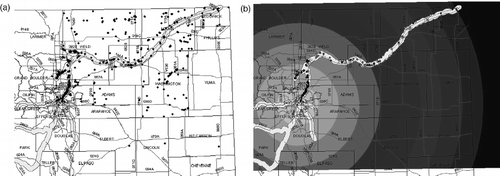
A temporal analysis of the permitted mine locations has been completed to determine the average distance of coarse aggregates from downtown Denver since the beginning of permitting in 1974. As expected, the temporal movement of coarse virgin aggregate sources moved downstream from Denver from 1970 until 1990, with one-way transport distance increasing from approximately 24 to 80 km (14.9 to 49.6 miles), as shown in Figure . However, the source distance began to decrease in 1990 and continues to decrease at the present. The decrease in transport distance can be explained by the increasing need for water resources near Denver as the population continues to increase. Aggregate sites near Denver that were once considered to be non-viable economically were reconsidered when the practice of constructing either slurry walls or compacted clay liners around the perimeter of the mine and using the massive hole in the ground as water storage vessels. The economics of aggregate mining were such that mines could break even economically on saleable aggregate and still turn profit from the sale of stored water to the surrounding municipalities. However, engineers and the ready-mix industry both agree that these sites near Denver have been depleted and it is expected that the distance travelled for coarse aggregate will soon increase. Currently, the approximate distance travelled for coarse aggregates to downtown Denver is 50 km (31 miles).
3. Beneficial waste-stream materials
Incorporating waste-stream materials such as recycled concrete aggregates and fly ash into concrete infrastructure can provide quantifiable environmental life-cycle impact and direct cost reductions when compared with ordinary Portland cement (OPC) concrete. The primary environmental savings comes from the avoided impacts of cement manufacturing, disposal of rubble in landfills and reduced transportation distance. The economic benefits of fly ash are evident; either the material is disposed of at a cost or sold for an economic gain. However, the economics of recycled aggregates are not found in direct costs, but in the reduced transportation costs due to the lesser distance from source to placement. In addition, if the concrete containing the waste-stream materials provides more durable infrastructure, i.e. longer service life, the environmental and economic impacts increase proportionally.
3.1 Recycled aggregates
It is estimated that annual worldwide generation of concrete and masonry rubble is roughly 1 billion tonnes (1.1 billion US tons; Lauritzen Citation1998). The growth of urban centres has created an ‘urban deposit’ of concrete where rubble from construction demolition can be processed into aggregate for new concrete infrastructure, significantly closer to the site of new construction, thereby lowering the associated transportation energy and cost (Wilburn and Goonan Citation1998). A unique example of this is the old Denver Stapleton Airport which was located just east of downtown Denver. The new Denver International Airport was opened 32 km (20 miles) northeast of the Stapleton area in 1995. An abundance of recycled aggregates due to runways, parking lots and other concrete infrastructure were immediately made available due to the subsequent redevelopment of the Stapleton area. This allowed for a unique opportunity for a multi-acre development to arise in an already defined urban area.
The current production of recycled aggregates in 2006 in the six-county Denver metropolitan area, a population of 2.4 million, is estimated at 3 million tonnes (3.3 million US tons; RMCI Citation2007). This represents less than 14% of the total required 21.6 tonnes (23.8 US tons) of aggregate for the region [9 tonnes per capita (9.9 US tons per capita)]. Increasing the recycled concrete content of urban infrastructure directly reduces landfill requirements, increases the longevity of natural aggregate resources and reduces the environmental and economic impacts due to lesser transportation requirements.
The future supply of recycled aggregates depends, in part, on mandating construction and demolition (C&D) debris recycling on a state or municipal level, as is currently mandated in California. As shown in Table , approximately 92% of C&D debris is generated during a structure's end-of-life phase – either renovation or demolition – this debris can either create a flow for landfilling or an input into new infrastructure if recycling and salvage is employed. The continued disposal of waste-stream flow into national landfills will continue to increase the environmental impacts of landfills across the country.
Table 1 Average C&D debris generation from structures (US EPA 1998).
Recycled concrete aggregates in comparison with virgin natural concrete aggregates are typically more porous and have higher water absorption (Poon et al. Citation2002). This can lead to higher water demand during mixing of the concrete. In addition, research has shown decreased compressive strength, tensile strength and modulus of elasticity at all ages, as recycled aggregate content is increased in concrete mixtures (Kou et al. Citation2007). Furthermore, increased recycled aggregate contents led to decreased resistance to chloride ion penetration and increased drying shrinkage and creep.
3.2 Fly ash
Fly ash can replace OPC on a 1:1 by mass basis and perform equally or superior up to certain replacement limits. The chemistry of fly ash reacts with any free lime left after cement hydration to form calcium silicate hydrate (C-S-H). The silica in fly ash combines with the calcium hydroxide (free lime) crystals to form more C-S-H paste, thereby reducing micro-cracking and creating concrete that is much less permeable. The formation of the C-S-H from the pozzolanic reaction results in increased strength at later ages. In addition, the fly ash has been observed to decrease chloride ion penetration and decrease drying shrinkage and creep for concrete mixtures containing recycled concrete aggregate (Kou et al. Citation2007). One disadvantage of increased replacement percentages of cement with fly ash is the decreased rate of strength gain.
The need to reduce the demand for cement is also a resiliency issue as any non-routine shutdown of cement plants creates an immediate shortage of cement in the Denver area. This was particularly evident in the summer of 2005 as was reported by the Denver Post (Citation2005):
Suppliers [of cement] have cut the amount available to contractors along the Front Range by up to 50 percent over the past few weeks, said Morrell, president of Concrete Frame Associates in Aurora.
The availability of fly ash is more market driven than driven by the availability of fly ash. Nationally, the beneficial use of coal combustion products is approximately 40%, as shown in Figure (ACAA Citation2006). The usage rate of fly ash is limited by insufficient information among engineers and owners regarding the beneficial use of fly ash for environmental and economic reasons, as well as the potential for superior durability and structural characteristics.
Although the capacity exists to supply more fly ash to Denver, should the market demand (ACAA Citation2006), the future material flow for fly ash as a common replacement for Portland cement is in question (Sanchez et al. Citation2008). On 15 March 2005, the US Environmental Protection Agency (EPA) issued the Clean Air Mercury Rule (CAMR) and the Clean Air Interstate Rule (CAIR) under Section 111 of the 1990 Clean Air Act in order to reduce emissions from US coal-based electric utilities. CAIR was established to reduce sulphur dioxide (SO2) by over 70% and nitrogen oxide (NO x ) emissions by over 60% from 2003 levels in 28 eastern states and the District of Columbia. CAMR was established to reduce mercury emissions in two phases: a first-phase cap of 34.5 tonnes (38 US tons) that is effective in 2010, and a second-phase cap of 13.6 tonnes (15 US tons) in 2018, for a total reduction of 70% from current levels (Edison Electric Institute Citation2005). These rules took effect on 18 July 2005. However, CAMR was vacated on 8 February 2008 (Liu et al. 2008a, 2008b, 2009). The EPA will go back to develop a more stringent rule to control mercury. These regulations have caused power plants to change their processes and produce a fly ash that may not meet ASTM C 618 specifications.
The effects of these regulations regarding the use of fly ash as a Portland cement replacement are yet to be fully evaluated as the impact of advanced mercury emissions control technology (e.g. activated carbon injection) and the placement of these technologies on the flow stream of the coal-fired power plants is uncertain. There is concern that the presence of increased concentrations of mercury, certain other metals or high carbon content may reduce the suitability of fly ash for use in some applications (e.g. use in Portland cement concrete; Sanchez et al. Citation2008). The concern for post-CAMR fly ash is the decrease in durability due to the effects of activated carbon on air-entraining admixtures. The air-entraining admixtures are required to increase air content in concrete mixtures and provide resistance to freezing and thawing. An ongoing study at the University of Colorado, Denver is examining the reuse potential of post-mercury-control fly ash in concrete (Liu et al. 2008a, 2008b, 2009). Specifically, the structural strength, durability and environmental leaching of post-mercury-control fly ash concrete is being tested and its life-cycle potential for GHG mitigation researched.
The current use of fly ash is considered environmentally suitable, even end-of-life applications of crushed fly-ash concrete as soil amendment (Reiner and Rens Citation2006, Reiner et al. Citation2007).
3.3 Role of durability in urban sustainability
Both the LCA impact and the economic cost of concrete urban infrastructure could be further reduced by utilising a more durable concrete mixture, thus extending the service life and requiring less replacement and operation and maintenance. To date, durability and high-performance concrete (HPC) are not necessarily synonymous. The American Concrete Institute (ACI) defines HPC as a specially engineered concrete where one or more specific structural characteristics have been enhanced, e.g. compressive strength. Durability has also been defined as the ability of concrete to perform satisfactorily with minimal maintenance over the anticipated service life of the structure (Hooton et al. Citation2006). However, these definitions do not specify that durability results in an extended service life.
4. Experimental testing
General acceptance of incorporating waste-stream materials into concrete infrastructure requires a knowledge that the final mixture will produce concrete equal to, or superior than, OPC concrete with regard to structural and durability performance. In addition, the mixture must be proven to be environmentally safe. Although the replacement of Portland cement with waste-stream materials, fly ash being common, is practised and accepted at low replacement levels – even a minimum mandated by the Colorado Department of Transportation (CDOT) for 10% in pavement (Class P) – the majority of engineers, architects and contractors are not familiar with specifying this replacement without incentive or mandate. Even though incorporating fly ash is commonly practised, there is little direct evidence of the impact on service life and the subsequent impact on LCA. In order to further the evaluation of fly ash and recycled aggregate inclusion on durability, testing was completed comparing OPC (control) with concrete mixtures containing Class C and Class F fly ash at a 1:1 replacement of OPC at 30% (C30 and F30) and 40% (C40 and F40). The mixtures maintained a CDOT Class B concrete specification of 336 kg/m3 (566 lb/yd3) total cementitious material (TCM) content with strength specifications of 20.7 MPa (3000 psi) at 28 days. The mixture designs and properties are included in Table .
Table 2 Mixture designs and fresh concrete property results.
The sources of fly ash were from the Monticello coal-fired power station in Mt. Pleasant, Texas (Class F) and the Comanche coal-fired power station in Pueblo, CO (Class C). The ASTM C 618 specifications of each ash are included in Table .
Table 3 ASTM C 618 specifications and results for Class C and Class F ashes.
All mixtures used South Platte virgin fine aggregate meeting ASTM C33, and all except the control (OPC) mixture used recycled concrete coarse aggregate meeting ASTM C33 from the previously mentioned Stapleton recycling site. The control mixture used virgin South Platte ASTM C33 coarse aggregate.
Prior to testing, a service life prediction model (Life-Citation365 2002) was run to evaluate the effect of fly ash inclusion on service life to provide a benchmark for comparison. The model evaluates the time required for sufficient chlorides to penetrate the concrete cover and accumulate in sufficient quantity at the depth of the embedded steel to initiate corrosion. Fly ash replacements of 30 and 40% (HPGC-30 and HPGC-40) were compared to OPC and OPC with a chemical corrosion inhibitor (e.g. calcium nitrite inhibitor) and the use of epoxy-coated steel. The chloride exposure conditions (e.g. rate of chloride build-up at the surface and maximum chloride content) were modelled as a parking structure in Denver, Colorado. As shown in Table , the increase time until first maintenance extends from 9.8 years in the base case to nearly 55 years when incorporating 40% fly ash as direct replacement for Portland cement.
Table 4 Life-365 results.
5. Hardened concrete property results
5.1 Compressive strength
The primary criterion of HPGC is that it meets or exceeds the required structural criteria, i.e. compressive strength. As shown in Figure , all mixtures met the 20.7 MPa (3000 psi) at 28-day criteria (CDOT Citation2006). The control mixtures experienced the highest 28-day compressive strength with a value of 38.5 MPa (5593 psi). The 30% replacement of Portland cement with Class C fly ash produced the second highest compressive strength reaching 30.2 MPa (4373 psi) at 28 days of age. The F30 and F40 concrete mixtures reached compressive strengths of 22.1 MPa (3208 psi) and 21.0 MPa (3043 psi), respectively, at 28 days of age. By 90 days of age, the F30 and C30 mixtures met the CDOT's requirements for all structural concrete classifications (Class B, BZ, D, DT, E, H, HT and P mixtures) except for the mixtures designated for high-strength concrete (Class S35, S40 and S50 mixtures). The F30 and C30 mixtures reached at least 31 MPa (4500 psi) at 90 days of age. The trend also indicates that the F30 and F40 mixtures would likely soon equal or exceed the control strengths at later ages.
5.2 Sodium sulphate expansion
In the Colorado eastern slope, high sulphate soils are common and have a nearly immediate effect on the durability of in-place concrete. The degree to which concrete exposed to sulphate soils or water deteriorates as a result of physical and chemical attack is directly related to the permeability of concrete (Mehta Citation2001). ACI 318-05 Table 4.3.1 classifies different levels of sulphate exposure based on the concentration of sulphate ions in the soil or water anticipated to be in contact with the concrete (ACI 2005). Table 2.3 of ACI 201.2R-01 has similar water-to-cementitious ratio (w/cm) and compressive strength requirements as ACI 318-05. The performance option requires optimising the cementitious materials and their amounts and is as follows:
-
moderate (Class 1) sulphate exposure – ASTM C 1012 expansion < 0.10% at 6 months;
-
severe (Class 2) sulphate exposure – ASTM C 1012 expansion < 0.10% at 12 months; and
-
very severe (Class 3) sulphate exposure – ASTM C 1012 expansion < 0.10% at 18 months.
Figure indicates that the expansion due to sodium sulphate was the lowest in the Class F fly ash mixtures, with negligible results for the F30 mixture. The C30 specimens experienced similar results as the control, however, the C40 behaved similarly to the Class F mixes until 6 months of exposure. The five mixtures met the criteria for a Class 1 ‘moderate’ sulphate exposure. Furthermore, the mixtures containing the Class F fly ash met the criteria for ‘severe’ Class 2 sulphate exposure with per cent expansion results less than 0.10% at 12 months. The per cent improvement from the control sample determined at 6 months and 1 year of exposure is summarised in Table . The reduced expansion due to sulphate attack in the Class F mixtures was likely due to the lower lime contents than the Class C ash (10.83% CaO for the Class F and 27.67% for Class C), as a lower pH in the pore fluid reduces expansion (Malhotra and Mehta Citation2002).
Table 5 Summary of 6-month and 1-year sodium sulphate testing.
5.3 Rapid chloride permeability
Because of the high alkalinity in concrete, a passive layer is created around steel and protects against corrosion from the mixture water. Chloride ions, typically from de-icing salts, that reach the steel will break down the passivity provided by concrete. ASTM C 1202, often called the rapid chloride permeability test (RCPT), passes an electrical charge, in units of coulombs, as an indication of performance criteria for permeability. Although the RCPT is not a direct measure of permeability, nonetheless there is a wide body of evidence that concrete with lower coulomb ratings using this test is more resistant to chloride ingress (SCA Citation2002, PCA Citation2010). As expected, the permeability of each concrete mixture decreased with concrete age (see Figure ). The mixtures containing Class F fly ash experienced equal or decreased permeability at 28 days of age when compared to the control 100% Portland cement concrete mixtures. Furthermore, the F30 and F40 mixtures were determined to have moderate permeability per ASTM 1202 at 90 days of age with readings of 2918 and 3172 coulombs, respectively. These mixtures had at least a 30% decrease in permeability at 90 days of age compared to the control mixture. The mixtures containing the Class C fly ash experienced higher permeability readings at 28 days of age when compared to the control mixture; however, they had comparable or slightly decreased readings by 90 days of age. When examining the fly ash replacement percentages, the mixtures with 30% replacement of cement with fly ash experienced decreased permeability when compared to mixtures with 40% replacement at 28 and 90 days of age. This is expected due to the reduced availability of calcium hydroxide in the mixtures containing 40% Portland cement. The calcium hydroxide is needed to react with the silica provided from the fly ash to produce C-S-H, the primary strength contributing cement hydration product.
5.4 Freeze–thaw resistance
Although the resistance to freezing-and-thawing cycling is a direct function of the air entrainment, and not related to the amount or class of fly ash (Malhotra and Mehta Citation2002), ASTM C 666 is a necessary durability test for regions that experience such temperature cycles. As shown in Figure , the fly ash mixtures performed equally or superior to the control mixture. The durability factor was determined from the frequency recorded at 300 cycles per ASTM 666. The durability factor for the five mixtures ranged between 84.4 and 86.3. Concrete mixtures with a durability factor greater than 60 are considered to have sufficient freeze–thaw resistance. A threshold value of 60 is derived from the ASTM C 666 standard in which the test is terminated when the relative dynamic modulus value reaches 60% of the initial (Klieger and Lamond Citation1994). Thus, all mixtures examined in this study are considered to exhibit acceptable durability. The overall durability of the fly ash mixtures was evaluated to contribute approximately 10% to the service life expectancy of concrete urban infrastructure. The impacts of increasing the service life were further evaluated in LCA and LCC terms.
6. LCA and economic impact of HPGC
The economic input–output (EIO) model incorporates aggregated environmental and economic data from all industrial sectors according to the 1997 US Department of Commerce EIO data (Carnegie Mellon Green Design Institute Citation2007). Input into the EIO-LCA model is economic only and is based on producer prices for the products in terms of 1997 dollars (USD). The model boundaries include the manufacturing and processing of concrete and the end-of-life phases for a concrete project located in downtown Denver, Colorado, as depicted in Figure .
Figure 8 LCA of concrete infrastructure in Denver, Colorado. Arrows represent transport and the dashed line represents the urban environment.
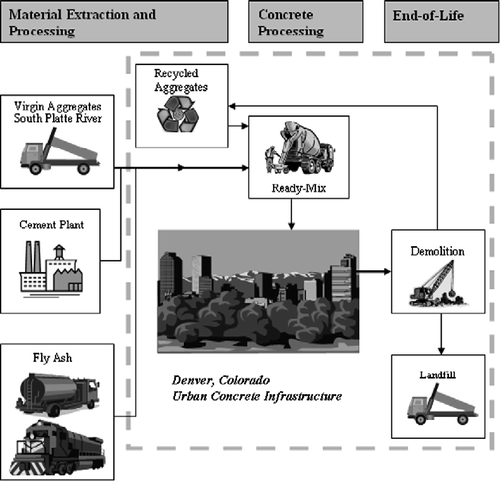
The environmental impacts of transport mode and distance, material processing and avoided environmental impacts of using recycled aggregate and fly ash are discussed in Reiner (Citation2007). The concrete flow into Denver was evaluated with scenarios identified as business-as-usual (BAU) and HPGC. The scenarios differ by material source and percentage incorporated waste stream, as shown in Table .
Table 6 Material replacement levels and source locations.
The HPGC scenarios that provide a replacement of fly ash achieve the greatest impact reductions, although even a substitution of recycled aggregates without fly ash (HPGC-5) can provide significant reductions of approximately 8% compared to the BAU-1 scenario. However, combining 40% cement replacement with 50% recycled aggregate (7-HPGC) provides approximately 41.5% reduction in CO2E and 40.0% embodied energy.
6.1 Concrete direct and life-cycle costs
As concrete mixtures are typically designed for service life expectancies greater than 25 years and they are not considered energy or water projects, LCC methodology according to the Federal Energy Management Program of the US Department of Energy, LCC rules and procedures (10 CFR 436, Subpart A), is not applicable. Rather, the Office of Management and Budget (OMB) Circular A-94, ‘guidelines and discount rates for Benefit–Cost Analysis of Federal Programs’ provides the necessary methodology and discount rates – for comparison of alternatives with the same service life. HPGC mixtures were evaluated using Building for Environmental and Economic Sustainability (BEES) for a LCC using a real interest rate (discount factor) of 3.5% (OMB Citation2006). All operation and maintenance expenses for the alternatives during the period of analysis are in base year 2002 dollars. The higher amount of fly ash substitution provided the greatest reduction in lifetime costs. The results indicate a 10.3% reduction in LCC results for the 35% fly ash concrete mixtures when compared to 0% replacement of Portland cement with fly ash (Reiner and Rens Citation2006).
However, LCC does not allow comparison of alternatives with different service lives, thereby not allowing the comparison of a longer durability with HPGC compared to OPC. Instead, the direct costs of the materials were considered to evaluate economic sustainability with the additional knowledge that the anticipated service life and reduced operation and maintenance would provide additional savings. In Table , the direct comparison of the scenarios is compared.
Table 7 Cost savings for 1 tonne of HPGC – Denver, Colorado.
7. City-scale HPGC applications
Applications in which the HPGC discussed in this paper have been implemented include a concrete pavement, precast manhole and prestressed double-tee beam. A HPGC mixture (H60) including a 60% cement replacement with Class F fly ash and w/cm equal to 0.31 was used for these Denver, Colorado, field applications (Reiner and Rens Citation2006, Reiner Citation2007). In 2004, AMCOR Precast, Inc. (Littleton, CO, USA) produced a 1.83 m (72 in.), height and diameter, precast manhole and base section with a 0.255 m (10 in.)-thick lid with an access hole using the H60 concrete mixture. The forms were stripped at 1-day without steam curing and the surface texture and appearance were considered to be good by AMCOR. The manhole was designed for AASHTO HS-20 traffic loading and was to be installed at a development project in Frederick, CO, in the winter of 2006. However, the project was never implemented due to contractor/owner negotiations and the manhole was never installed.
The City and County of Denver Streets Department volunteered to use the H60 concrete mixture for an alley panel in 2004 on the condition that 28-day compressive strength be 17.2 MPa (2500 psi). For comparison, traditional concrete pavement mixtures were placed next to the HPGC panel. This field application was significant in that the HPGC was mixed by a local ready-mixed concrete batch plant and delivered by conventional means. The 3-day compressive strength of 21.4 MPa (3100 psi) was adequate to open the alley to traffic.
In 2005, the Rocky Mountain Pre-stress Plant produced a prestressed structural double-tee girder and slab using the H60 mixture. For comparative purposes, the mixture was modified to substitute Class C fly ash for Class F and Type III cement (high early) for Type I/II cement. The mixture produced satisfactory compressive strengths, particularly at 1 day of age. The double-tee girder was load tested following ACI 318-20 ‘strength evaluation of existing structures’ and performed well.
A pervious concrete pavement was constructed on the campus of the University of Colorado Denver that incorporated a 20% cement replacement with Class C fly ash (Hager et al. Citation2008, Kocman et al. Citation2008, Hager et al. Citation2009). In addition, the coarse and fine aggregate drainage layers of the pavement system consisted of 100% recycled concrete aggregate and 10% replacement of sand with crushed recycled glass, respectively. The ‘green’ porous pavement system is performing as expected, both structurally and hydrologically.
8. Conclusion
The Class F fly ash mixtures provided equal or superior results than the Class C mixtures and the control mixture for permeability, freeze–thaw and sulphate expansion tests. The freeze–thaw tests resulted in little difference in durability of all mixtures investigated. Thus, all performed on an equal basis. This was likely due to comparable air entrainment more than the fly ash content of the mixtures.
In terms of compressive strength gain, the mixtures containing Class C fly ash gained strength similarly to the control mixture and would satisfy the early strength requirements for most applications. Class F concrete mixtures could likely be proportioned to meet most structural 28-day requirements at 30% or less replacement, depending on the TCM. Ultimately, the more C-S-H produced by the fly ash concrete mixtures, particularly Class F fly ash, at later ages would likely result in the concrete mixtures surpassing the control strengths with similar TCM. The inclusion of recycled concrete aggregate had no negative effect on the strength or durability performance of any mixtures. The environmental and economic benefits of a HPGC mixture should be considered in determining these criteria for specific applications. Potential recommendations for Denver, Colorado, would include at least a 20% replacement of Portland cement with Class F fly ash and up to 100% of recycled aggregate for the coarse aggregate fraction of the concrete mixture for all elements.
Although the Class C fly ash concrete mixtures did not perform as well as the Class F mixtures in the durability tests, the mixtures performed equally or superior to the control and are, therefore, still classified as HPGC. Based on the results of the sulphate expansion tests, concrete in contact with water and sulphates should incorporate up to 40% Class F fly ash.
The research conducted herein substantiates that incorporating waste-stream materials into concrete infrastructure provides quantifiable environmental life-cycle impact and direct cost reductions when compared with OPC concrete.
Additional information
Notes
References
- ACAA . 2006 . American Coal Ash Association: coal combustion product production and use survey Retrieved January 2007. Available from: http://www.acaa-usa.org/PDF/2003_CCP_Survey(10-1-04).pdf
- ACI . 2005 . “ American Concrete Institute: building code requirements for structural concrete (318-20) and commentary (318R-05) ” . In ACI-318
- Carnegie Mellon Green Design Institute, 2007. Economic Input–Output life cycle assessment. Available from: http://www.eiolca.net/index.html
- CDMG . 2006 . Colorado Department of Minerals and Geology Retrieved from GIS Data. Available from: http://mining.state.co.us/GIS%20Data.htm
- CDOLA . 2006 . Colorado Department of Local Affairs Retrieved from population data. Available from: http://dola.colorado.gov/info_publications.html
- CDOT . 2006 . Colorado Department of Transportation Retrieved from: http://www.dot.state.co.us/designsupport/Construction/2005SpecsBook/2005SSP/601sc.doc
- Denver Post . 2005 . “ Concrete shortage ” . In Business section: C1
- Edison Electric Institute . 2005 . Cap-and-trade: a cap-and-trade program will reduce mercury emissions and deposition Retrieved from EEI: http://www.eei.org
- GPEC . 2006 . Greater Phoenix Economic Council Retrieved October 2006. Available from: http://www.gpec.org/InfoCenter/Topics/Demographics/HistoricalPopulation.html
- Hager , A. , Ramaswami , A. and Rens , K.L. 2008 . “ Characterization of construction and demolition debris in the City and County of Denver ” . In Global waste management symposium September 7–10, 2008, Copper Mountain, CO, USA
- Hager , A. , Rens , K.L. and Durham , S. 2009 . “ Sustainable design of pervious concrete pavements ” . In Engineering sustainability 2009 19–21 April 2009, Pittsburgh, PA, USA
- Hooton , D.R. 2006 . Proportioning and testing concrete for durability . Concrete International , point of view
- Klieger , P. and Lamond , J.F. 1994 . Significance of tests and properties of concrete and concrete-making materials , Philadelphia, PA : American Society for Testing and Materials .
- Kocman , S. 2008 . “ Waste incorporated porous landscape detention and pervious concrete pavements for sustainable urban stormwater management ” . In Global waste management symposium 7–10 September 2008, Copper Mountain, CO, USA
- Kohler , S. 2006 . Aggregate availability in California , Map sheet 52 Sacramento, CA : Department of Conservation, California Geological Society .
- Kou , S.C. , Poon , C.S. and Chan , D. 2007 . Influence of fly ash as cement replacement on the properties of recycled aggregate concrete . Journal of Materials , 19 ( 9 ) : 709 – 717 . American Society of Civil Engineers
- Lauritzen , E.K. 1998 . “ The global challenge for recycled concrete ” . In Symposium sustainable construction; use of recycled concrete aggregate , Edited by: Dhir , R.K. , Henderson , N.A. and Limbachiya , M.C. 505 – 519 . London : Thomas Telford .
- Life-365, 2002. Life 365, Version 1.1 – Silica Fume Association. Downloaded 2002. Available from: http://www.silicafume.org/specifiers-lifecycle.html
- Liu , R. 2008a . “ Comprehensive utilization of fly ash in civil engineering infrastructure in the United States and China ” . In Global waste management symposium 7–10 September 2008, Copper Mountain, CO, USA
- Liu , R. 2008b . “ Influence of mercury control technologies on the beneficial use of fly ash ” . In Poster presentation at EPA's 2008 beneficial use of industrial materials summit 31 March–3 April 2008, Denver
- Liu , R. 2009 . “ LCA of post-mercury-control fly ash concrete ” . In Poster presentation at 2009 symposium on industrial ecology for young professionals 17 May 2009, Tempe
- Malhotra , V.M. and Mehta , P.K. 2002 . High-performance, high-volume fly ash concrete: materials, mixture proportioning, properties, construction practice, and case histories , Ottawa : Supplementary Cementing Material for Sustainable Development .
- Mehta , P.K. 2001 . Sulfate attack on concrete: separating myths from reality . Concrete International , 22 : 57 – 61 .
- NRC . 2004 . Materials count: the case for material flows analysis Committee on Material Flows Accounting of Natural Resources, Products, and Residuals, Committee on Earth Resources – National Research Council
- OMB . 2006 . Office of Management and Budget Retrieved from Circular A-94; Appendix C: Available from: http://www.whitehouse.gov/omb/circulars/a094/a94_appx-c.html
- PCA . 2006 . North American cement industry annual yearbook – 2005 , Skokie, IL : Portland Cement Association .
- PCA, 2010. Concrete technology – durability. Available from: www.cement.org/tech/cct_dur_corr_resistance.asp
- Poon , C.S. , Kou , S.C. and Lam , L. 2002 . Use of recycled aggregates in molded concrete brick and blocks . Construction and Building Materials , 16 : 281 – 289 .
- Reiner, M.B., 2007. Technology, environment, resource and policy assessment of sustainable concrete in urban infrastructure. Dissertation (PhD). University of Colorado Denver, May 2007
- Reiner , M. and Rens , K.L. 2006 . “ High-volume fly ash concrete: analysis and application ” . In Practice periodical on structural design and construction Vol. 11(1) , 58 – 64 . ASCE
- Reiner , M.B. , Rens , K.L. and Ramaswami , A. 2007 . Sustainability of the urban built environment: a bulk material flow analysis, one material at a time . Journal of Engineering for Sustainable Development for Energy, Environment and Health , 2 ( 1 )
- RMCI, 2007. Recycled Materials Company, Inc., Personal Communication (M. Reiner, Interviewer)
- Sanchez, F., et al., 2008. Characterization of coal combustion residues from electric utilities using wet scrubbers for multi-pollutant control. US Environmental Protection Agency. Office of Research and Development. EPA-600/R-08/007, July 2008
- SCA . 2002 . Reducing permeability – slag cement in concrete , Vol. No. 6 , Woodstock, GA : Slag Cement Association .
- UN . 2003 . United Nations – World urbanization prospects , New York City : Population Division .
- USCB, 2002. Retrieved from: http://www.census.gov/econ/census02/data/metro1/M1974031.HTM#N327
- US Department of Labor, 2006. Retrieved from: http://www.bls.gov/ppi/
- US EPA, 1998. Characterization of building-related construction and demolition debris in the United States, EPA530-R-98-010, Page ES-3, June
- USGS . 1999 . Fact sheet: natural aggregates – foundation of America's future Retrieved from: http://minerals.usgs.gov/minerals/pubs/commodity/aggregates/fs14497.pdf
- US Mayors Climate Protection Agreement, 2005. Retrieved from: http://usmayors.org/climateprotection/agreement.htm
- Wilburn , D.R. and Goonan , T.G. 1998 . Aggregates from natural and recycled sources – economic assessments for construction applications – a material flow analysis US Geological Survey Circular 1176, 36 p. Available only online at URL http://greenwood.cr.usgs.gov/pub/circulars/c1176/
- Worrell , E. 2001 . Annual review of energy and environment , Publication number LBNL – 49097 Vol. 26 , 303 – 329 . Berkeley, CA : Lawrence Berkeley National Laboratory .

